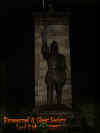| |
For a few years while living down here in
Florida I have always wanted to visit this site. Back when I first
relocated to FL the site was just being recognized as a state park and
being excavated for studies. Alot of people are not aware of the long
history this site has so some of it I am going to post in an article I
found below.
Aside from that in the history books their was
two Fort Mose's in St. Augustine. The first one was founded in 1738 by
some escaped slaves from various southern States. They came to the Spanish
Colonies because Spain at that time was not enslaving the black
communities. The group of men, women and children lived in palmetto huts
much like the Indians surrounded by log walls.
The leader of this group was Francisco Menendez
who was the captain of this fort. Eventually the camp had to be abandoned
and this community took shelter at Castillo
San Marco...another for we investigated a couple years ago. When
Fort Mose was abandoned the British Army took control of it in 1740 and
used it as a staging area to attack Castillo San Marco whose walls
absorbed cannon balls.. The black militia did defend the Spanish Army and
the British were overcome. Florida may have been a different sort of state
if the British took control of course at one time they did just as Spain
did just as the US did!
The site is known to be the earliest known
legally sanctioned free black community in the United States. But it was
not just inhabited by Black Slaves the native Americans were present
here...British....Spanish and even Americans. That is ALOT of energy over
the years. Most of the runaway slaves came from British Colonies of SC and
GA who really abused their slaves. The slaves were actually escaping since
1687 so this was more of a leading up to the forming of Fort Mose.
It is the precursor site for the Underground
Railroad and the second Fort Mose was built nearby in 1752. It was the
Spanish Governors who helped build the fort since it was the slaves who
offered to assist them in fighting the British. It actually is ironic
because Spain mistreated the Indians while the British Mistreated the
Africans my how history is like a double sided coin. The Spanish followed
a simple rule which was convert to Catholicism and fight for us or die it
was that simple that was proven when 250 French men were slaughtered
outside of St Augustine for not submitting to Christ in the name of
Spain.
I think was fueled all of this was in the 1600s a
Chisia Yuchi woman escaped slavery in SC and reported to the Spanish that
the English were teaching the Chichinecoa and Westo tribes to attack
Florida and the missions the Spanish built and by the 1700s almost all of
them were destroyed. When that slave escaped to warn the Spanish of this
she set the tone for other slaves they were able to come to Florida and
establish what was known as Fort Mose or rather the first black town in America
also called Fort Moosa or....Gracia
Real de Santa Teresa de Mose. So the fort although not forming till the
1700s the uprising and community did secretly exist around 1683.
In
1783 the American Revolution had ended and another fort was built on the
Apalachicola River and would be left by the Britain's for use of the
Spanish and Blacks. The British had abandoned Fort Mose or rather Negro
fort as some called especially the local Indians and former slaves. The
fort once again was inhabited by the freed slaves once Spain regained
control.
The
fort would suffer from then on harsh times as in 1812 it was burned to the
ground during the Patriot War then rebuilt only to have in 1816 American
Gunboats fire upon the fort. Those heated cannon balls struck one of the
magazines igniting all its gunpowder. The explosion was so great that over
300 men died instantly which included children, men, women and even some
Americans believe it or not. It just goes to show you how our government
is willing to kill its own people for its own gain. Once again the
American people have been deceived and those that support our government
support the fact that our own blood was spilled along with many other
innocents which is nothing to be proud of. That is why even as an American
I do not pledge my allegiance to this nation because my sites purpose is
to make others aware of the truth if you know the truth then you will
understand that if history was covered up who is to say our government
does not cover up UFOs....and other paranormal creatures that wander this
planet? Think about it!!!
Basically
the Slaves ran from the British...only to have the US defeat the British
and destroy the Negro fort to make them their own slaves. It actually is
quite tragic because the slavery was not just given to the Blacks but the
Seminoles and any other tribe in FL. Not only that but despite the Fort
being destroyed a few times it played a huge role in holding back 200,000
troops over a three year period. You see Florida is like a jungle so the
native American and blacks practices guerilla warfare. Many lives were
lost and eventually the civil war came along and this community had its
finally stand for freedom which was won by the north and of course at that
point on the large Fort Mose community broke apart starting other communities
like the one we visited in Port Orange for example called Freemanville!
The
terrain is much similar to Fort
Matanzas another fort we investigated just south of here which
today is still in tact. Just like fort Matanzas this one sat also in the
marsh. Not much today remains just a board walk leading up the center of a
Marsh where once this village and fort once stood. I do deem this as
one of the very haunted sites in FL and I also am the first to conduct an
investigation of it alot of energy is present here alot of tragic deaths
took place even though not much remains in the photos you see but nature
it at one time was a bustling community!
©
By
Lord
Rick

















Black
Seminole Wars and Fort Negro
http://www.emergingminds.org/magazine/content/item/1374
Did you know that African Americans fought the U.S. Army to a standstill
in a 7 year war from 1835-1842?
Up until when the British (and then the U.S.) acquired Florida from Spain,
Florida was a unique safe haven for fugitive Africans to escape and find
refuge from terrorist American slave owners. Because the Spanish were much
more accommodating to Africans than the English terrorist; Africans who
were able to escape the grips of slavery were given refuge in Florida and
were integrated into a cohesive, multiracial, multicultural community.
The African men worked as jewelers, butchers, and innkeepers, while the
women worked as cooks and laundresses, and in 1681, these African
Americans established a settlement for runaways called Gracia Real de
Santa Teresa de Mose, becoming the first free Black settlement in North
America.
"Fort Mose" as it came to be called, was located just north of
St. Augustine, Florida. It was a diverse community of African Americans
and American Indians that developed into a complex family network through
interracial relationships. When Florida was ceded to Britain under the
1763 Treaty of Paris, many of the free blacks along with their Indian
allies were resettled in Cuba by the Spanish government. Along with the
habitants of Fort Mose, it is estimated that a least 251 British slaves
joined the Spanish entourage to Cuba under their sanctuary policy, while
hundreds of others African Americans fled to the swamps of South Florida
or to the flourishing villages of the Seminoles in North Florida. It is in
the villages in North Florida where African Americans would make history
by using guerrilla warfare tactics to battle the U.S. Army.
After the British finally lost the war of 1812 to the U.S, they had to
evacuate Florida and in the spring of 1815 gave a fully-armed,
well-crafted fort on the Apalachicola River to about 300 African Americans
and 30 Seminole and Choctaw Indians that helped the fight against the U.S.
"Fort Negro" was the name it took on and as the news spread of
its existence, it attracted as many as 800 escaped Africans who settled in
the surrounding area. Because the word Seminole means "wild
people" or "runaway," this community of African Americans
became known as the "Black Seminoles."
Under the command of its Black General named Garson and with the help of
Native American allies, the inhabitants of Fort Negro provided protection
against white slave hunters for the Seminole community for about a year.
It has been reported that within this year news of this Negro military
fort spread to plantations as far away as Tennessee and the Mississippi
Territory as fugitive Africans escaped from these areas to freedom at the
Negro Fort.
Under mounting pressure from Georgia slaveholders, General Andrew Jackson
instructed his soldiers to destroy the fort, and after a series of
skirmishes in which the Black Seminoles won easily, U.S. troops were sent
in to Florida to fire cannons into the fort that eventually caused an
explosion that demolished it. Although many of the Black and Indian
warriors were killed or captured and forced back into slavery,
fortunately, hundreds of others were able to retreat to the swamps and
live to fight another day.
Somehow, the Seminoles in North Florida were able to rebuild their
communities in the dense terrain of Florida as white people continued to
not let these people of color live peacefully. They built at least 15
villages up and down the gulf coast of Florida and fought hundreds of
small skirmishes against white terrorist until finally, with the backing
of the Army, the U.S. government decided that the only solution to end the
hostilities in Florida was to relocate all non-Whites west. Their attempts
to remove all people of color from Florida caused three wars,
appropriately called the "First Seminole War," the "Second
Seminole War," and the "Third Seminole War." Although the
Black Seminoles fought gallantly in all three wars, Emerging Minds found
the 7 year "Second Seminole War" to be the war where African
Americans were the most involved and most successful.
The Second Seminole war started with the Treaty of Payne's Landing, signed
by a small number of Seminoles in May 1832. This treaty required the
Seminoles to give up their Florida lands within three years and move west.
But little did the U.S. know that the Black Seminoles had nothing to do
with this treaty, and when the U.S. Army arrived in 1835 to enforce the
treaty, the Seminoles were ready for war.
This war turned out to be a "War of Independence" for the
Blacks. Some authorities say that this was the time that they emerged as a
distinct social group because they shared the experience of running away,
resisting slavery and fighting for their freedom. General Thomas Jesup,
the commander of the U.S. Army in Florida, once wrote in reference to the
Second Seminole War "Throughout my operations, I found the Negroes
the most active and determined warriors; and during my conference with
Indian chiefs I ascertained that they exercised an almost controlling
influence over them." Later he wrote, "This you may be assured
is a Negro and not an Indian War."
After 7 years of fighting with no abate, General Jesup resorted to
expedience to end this long, bloody and costly war. He agreed to grant
freedom to the Blacks if they would call a truce and go west as part of
the Seminole Nation. The Black Seminoles reluctantly agreed due to
depleted forces and short supplies and the Second Seminole War ended as
the longest and most expensive war waged by the U.S. government on
American soil. The United States spent more than 30 million dollars, lost
more than 1,500 soldiers, and thousands of white settlers were killed.
The campaigns of the Second Seminole War were an outstanding demonstration
of guerrilla warfare by the Seminoles. With only 3,000-5,000 soldiers, the
Seminoles were able to fight over 200,000 U.S. soldieries to a virtual
standstill. Although, many of the Black Seminoles were still forced to
move west into present day Oklahoma, (and later into Texas and Mexico)
they never surrendered and waged a war against the U.S. that has not been
matched to this day. Though much of this history has been suppressed by
white supremacist historians, recently published information on this
African American military campaign now has some historians calling this
seven-year war the largest slave rebellion in United States history.
Web Resources:
http://www.pbs.org/wgbh/aia/
http://www.georgiaencyclopedia.org/nge/Article.jsp?id=h-842
http://history.jupiter.fl.us/BlackSeminoles.htm
|
m |




















